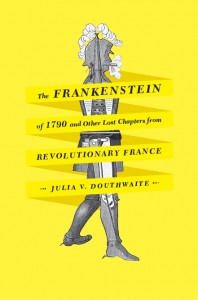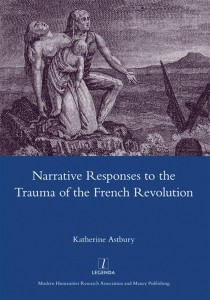One thing you should probably know: I come from a political family. My dad, “G.K. “Jeff” Douthwaite, was a state legislator (Democrat, Washington State, 43rd district) for three terms during my adolescence and I was deeply involved in all three campaigns. I have fond and somewhat bizarre memories of the Soul Food dinners we attended in church basements and the Hell’s Angels types who occasionally filled our house to help stuff envelopes. This was during the Civil Rights movement, the beginning of the Green movement, and a heady time was had by all. (Interestingly, historian Lynn Hunt also comes from a political family; her mom was a long-time city councilwoman. Also a Democrat.) For me, then, the French revolution is not just a subject of study, it is a vocation.
I really enjoyed doing the research that went into this book and which lasted about a decade. After tracking down and reading the 300-some fictions which constitute my final corpus, it took about 10 months to structure the material into a coherent book. I had to leave out one chunk that exists in article form instead, on the Festival of the Federation, because it did not leave any traces in the afterlife of the Revolution. My wilfully speculative Codas are an attempt to disprove Francois Furet’s oft-cited comment that the Revolution is over. On the contrary, I seek to show that the revolution was not over on “Thermidor” year II (when the Terror supposedly ended with the execution of Robespierre). And that it was kept alive, ridiculed, admired, satirized, and otherwise memorialized in later years, from 1794 up to 1904. Ultimately, each generation keeps the memory of the Revolution alive, as Mary Shelley, Honoré de Balzac, and Helen-Maria Williams did for theirs.
The one thing that feels unfinished about my book, however, is the label that I gave my method in a somewhat tongue-in-cheek moment: “new positivism.” This irreverential moniker unleashed a little flurry of objections at last year’s convention of the French Historical Society in Cambridge and has raised a question or two among the book’s reviewers too, so I’d like to take this opportunity to start clarifying what I mean. (A longer article is in the works.)
New positivism is a neologism that joins two opposing concepts: novelty or innovation and one of the most old-fashioned and unpopular forms of scholarly study. A targeted attack on positivism can be found in the masthead of the book series, “Flash Points,” which was founded and launched at the UCPress by a group of English professors in the California system. As the editors declare in their mission statement: “The series solicits books that consider literature beyond strictly national and disciplinary frameworks, distinguished by their historical grounding and their theoretical and conceptual strength. We seek studies that engage theory without losing touch with history, and work historically without falling into uncritical positivism.”[1] The opposition posited there—between a theoretically-informed and engaged historicism, on the one hand, and an uncritical positivism on the other hand—should give us pause. Positivism may be more fact-oriented and less philosophical than some might like, true. But it is erroneous to assume that positivism was ever unconnected from the world of politics; indeed Auguste Comte invented positivism specifically to usher in what he hoped would be a broad-ranging, political platform intended to explain laws of human conduct and ultimately free people from prejudice and hatred.[2]
However, Comte is less an inspiration than his successor, Fustel de Coulanges, whose ‘positivism of the document’ had no such liberating claims, except in the realm of fact-producing. In his History of the Political Institutions of Ancient France, Fustel de Coulanges argued: “[if] one may hope to succeed in the matter, it can only be by a patient study of the writings and documents that each age has left of itself.” [3] Coulanges’s model of a scientific kind of history-writing was close to that of a group of scholar-politicians whose desire to emulate the German example had been increased markedly by the shock of the 1870-1871 defeat,” writes Ernest Breisach, “They aimed at wresting dominance away from the amateurs or littérateurs who gave stirring lectures at the Collège de France and the Sorbonne.” Similarly, my model of a positivist literary history aims to wrest influence away from social sciences largely writ. I argue that literary documents—when triangulated with the press and historiography of a given time and place—can shed new light on socio-political developments and furthermore can engage with audiences in lively and inspiring ways. This involves embracing Coulanges’ rigor but paired to a more playful attitude about the stories we tell and the reader’s engagement with them.
I am not the first person to embrace positivism in our time; indeed Foucault and Habermas both adopted some kind of positivism in their famous works. Like Foucault in The Order of Things, I made this move because of disappointment with my field. Literary studies in French have fallen into a self-induced irrelevance since the 1980s because of an over-investment in philosophy, and especially deconstruction. This has produced some scholarship that may appear innovative on first sight but which fails the test of time. The stakes are even higher in the revolutionary period, when words were invented and allegiances changed from month to month. Literary scholars who have ventured into the revolutionary period without requisite knowledge of political history have committed some embarrassing errors. Historians have also committed some lapses, by integrating literary documents into their explanations without considering the importance of genre or the author’s biography.
So I use the term positivism as shorthand for strict attention to the textual universe of a work’s time and site of origins. I am trying to figure out what an imagined middle-of-the-road, politically moderate reader might have understood during the initial life of the books in question. I attain that goal by reading of newspapers, biographies, and book reviews, mainly, as well as other print materials—pamphlets, caricatures, artwork, some songs and speeches. I admit that I am borrowing only certain tenets from the founder of positivism Auguste Comte and other proponents of the 19th century, but I prefer positivism over the term philology, for instance, because I like the distant echo of positivism’s utopian ethos and combative stance. My next project will study how novelists of the 18th and 19th centuries created relevance for their stories by incorporating current events and human interest stories related in the press.
Conclusion
Each of us who writes or teaches the French Revolution does so for different reasons, and those reasons are rooted in our own situation. My 22 years of teaching at a wealthy Catholic institution situated in a poor, working-class city may have something to do with it, as well as my political views inherited from childhood. Many scholars aspire to a dispassionate and even censorious attitude toward the revolutionary past. This is unsurprising, especially as in the case of Astbury’s book or Marisa Linton’s latest work, Choosing Terror, which relates the deadly infighting amongst the Jacobins in Years I and II. When describing a family in mourning or an imminent threat, an attitude of worried concern and disapproval make sense. “Trauma ” may be a blunt instrument to describe it, but it is certain that events of 1793-94 caused widespread and negative emotional impact on some parts of the French citizenry.
But for me, it is the accomplishments of the Revolution that ultimately win out and merit our friendly concern. When I think about the persona I’d like the reader to take away from The Frankenstein of 1790, it is that of a story-teller and long-distance sympathizer. I’d like the reader to enjoy the great stories and larger-than-life characters of this period and be intrigued to look around and see what else carries on their legacy today. That’s the “newness” of the positivistic approach I’m endorsing.
Hybrid and marked by their own provenance, as all books must be, my work could be considered as arising from the same spirit of Pierre-Francois Palloy, the man who excavated and then repurposed the stones of the Bastille into an entire industry of miniatures, toys, and souvenir items of political memory. As described by Richard Taws in his new book The Politics of the Provisional, Palloy’s contributions need to be appreciated in two ways: 1) as deeply rooted in the original sources; and 2) as constantly involved in the process of making themselves anew. Taws argues that Palloy’s work is important “for its troubling insistence on the persistence of the past in the revolutionary present; for complicating the straightforward division of objects, histories, and people into new and old; and for forcing reflection upon the paradoxical conditions of materiality in 1790s France.”[4]
May we all aspire to such a feat!
[1] Founded by Catherine Gallagher (English, UCBerkeley) and Judith Butler (Rhetoric, UC-Santa Cruz), the series now operates out of Northwestern UP. The editorial board includes Ali Behdad, Edward Dimendberg, Jody Greene, Susan Gillman, and Richard Terdiman.
[2] For more on Comte’s intentions, see Larry Laudan, “Towards a Reassessment of Comte’s méthode positive,”
Philosophy of Science, Vol. 38, No. 1 (Mar., 1971): 35-53.
[3] Cited in Ernst Breisach, Historiography: Ancient, Medieval, and Modern (Chicago: University of Chicago Press, 1983), 276.
[4] Richard Taws, The Politics of the Provisional: Art and Ephemera in Revolutionary France (University Park, PA: Pennsylvania State University Press, 2013), 107.


